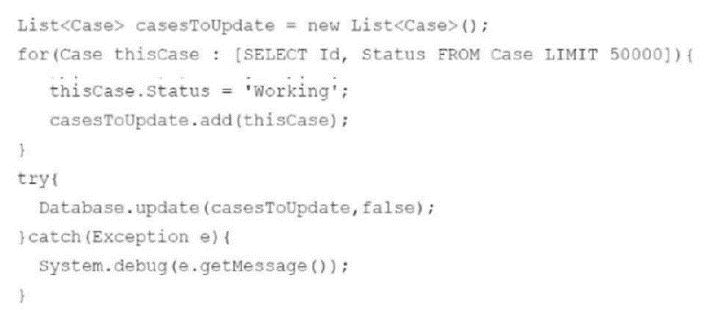Salesforce Certified Platform Developer (Plat-Dev-201) Exam Practice Test
Which two settings must be defined In order to update a record of a junction object?
Choose 2 answers
Answer : B, C
Option B: To update a junction object, the user needsRead/Writeaccess to the primary relationship object.
Option C: The user must also haveRead/Writeaccess on the junction object itself.
:Junction Objects Documentation
What are two benefits of using declarative customizations over code?
Choose 2 answer
Answer : A, D
Declarative customizations, such as workflows, process builder, validation rules, and flows, offer a no-code approach to customizing Salesforce. Below are the key benefits:
Declarative customizations automatically update with each Salesforce release (A):Salesforce ensures that declarative tools are automatically updated during new releases, eliminating the need for manual intervention or code refactoring.
Declarative customizations generally require less maintenance (D):Because declarative tools use configurations rather than custom code, they are simpler tomanage, troubleshoot, and update. This significantly reduces the maintenance overhead compared to custom code.
Incorrect Options:
B:Declarative tools do not automatically generate test classes. This is specific to Apex code.
C:Declarative customizations can still result in runtime errors, such as invalid field updates or logic conflicts.
A development team wants to use a deployment script to automatically deploy to a sandbox during their development cycles.
Which two tools can they use to run a script that deploys to a sandbox?
Choose 2 answers
Answer : A, D
SFDX CLI (A):Salesforce CLI allows the automation of deployment scripts to sandboxes. Using commands likesfdx force:source:deploy, developers can deploy metadata directly from source control.
Ant Migration Tool (D):The Ant Migration Tool is a command-line utility used for automating metadata deployments. It uses build.xml files to script deployments to sandboxes or production.
Incorrect Options:
B:Developer Console does not support deployment scripting.
C:Change Sets cannot be scripted; they require manual selection and deployment.
When the code executes, a DML exception is thrown.
How should a developer modify the code to ensure exceptions are handled gracefully?
Answer : C
Why a try/catch block is required:
In Salesforce, DML operations such as insert, update, delete, and upsert can throw exceptions due to issues like validation rule violations, field constraints, or sharing rule restrictions.
Using a try/catch block ensures that these exceptions are caught and handled gracefully, preventing the entire transaction from failing.
How to modify the code:
The update statement in the code can be wrapped in a try/catch block to catch and handle any exceptions that occur. For example:
apex
Copy code
public static void insertAccounts(List<Account> theseAccounts) {
try {
for (Account thisAccount : theseAccounts) {
if (thisAccount.website == null) {
thisAccount.website = 'https://www.demo.com';
}
}
update theseAccounts;
} catch (DmlException e) {
System.debug('DML Exception: ' + e.getMessage());
}
}
Why not the other options?
A . Implement the upsert DML statement:
upsert is used to either insert or update records based on an external ID or primary key. It does not inherently handle exceptions.
B . Implement Change Data Capture:
Change Data Capture (CDC) is used for tracking changes to data in real time and is unrelated to handling DML exceptions.
D . Remove null items from the list of Accounts:
While cleaning the input data is a good practice, it does not address the need for exception handling during DML operations.
Apex Error Handling
DML Operations in Apex
A custom picklist field, Pool Preference , exists on a custom object. The picklist contains the following options: 'Vegan', 'Kosher', 'No Preference'. The developer must ensure a value is populated every time a record is created or updated.
What is the optimal way to ensure a value is selected every time a record is saved?
Answer : D
Marking the field as required on the field definition ensures that the field is always populated during record creation or update. This enforces the rule at the database level.
Other Options:
Option A: Setting a default value ensures a value is present initially but does not enforce a value during updates.
Option B: Writing a trigger is less efficient and adds unnecessary complexity.
Option C: Marking the field as required on the page layout is UI-specific and does not enforce the rule during API or code-based operations.
:Field Level Requirements
Given the following Anonymous block:

What should a developer consider for an environment that has over 10,000 Case records?

What should a developer consider for an environment that has over 10,000 Case records?
Answer : C
The code provided processes allCaserecords in a single transaction. Since it attempts to process over 10,000 records, it exceeds the Salesforce governor limit of 50,000 DML rows per transaction, causing the transaction to fail.
Governor Limits on DML Rows (C):Salesforce enforces a governor limit of 50,000 rows for DML operations per transaction. In this case, if theSELECTquery retrieves over 50,000 records, theDatabase.updatecall will hit this limit and throw aSystem.LimitException.
Why the Try-Catch Block Fails to Handle Limits (B & D):Governor limit exceptions (System.LimitException) cannot be caught by try-catch blocks. Therefore, the exception cannot be handled, and the transaction will fail.
A team of developers is working on a source-driven project that allows them to work independently, with many different org configurations.
Which type of Salesforce orgs should they use for their development?
Answer : D
Scratch orgs are temporary, source-driven Salesforce environments used for development and testing. They allow developers to:
Work on independent features without interfering with each other's configurations.
Utilize a source-driven development model for CI/CD pipelines.
:Scratch Orgs Overview